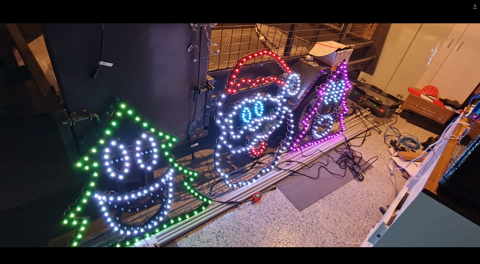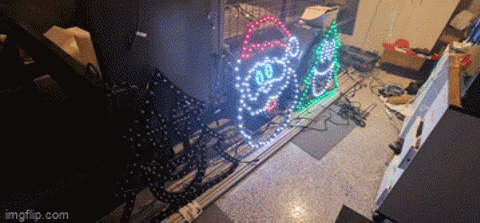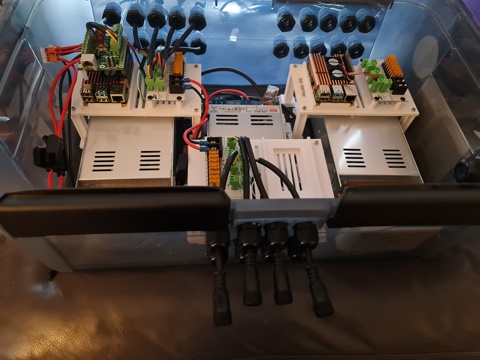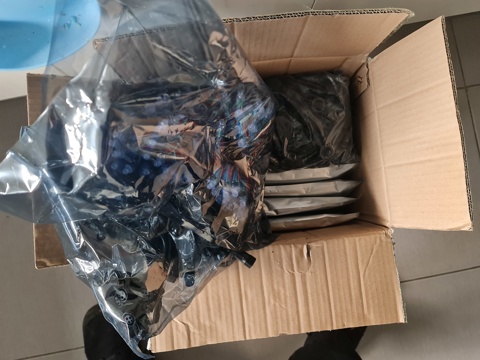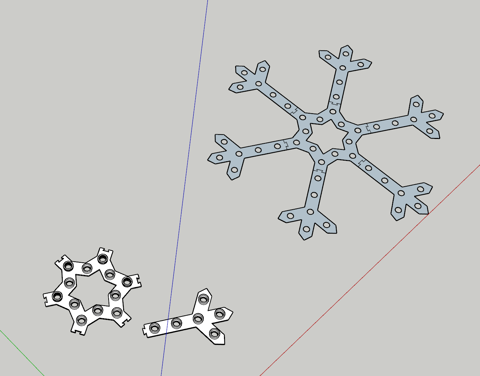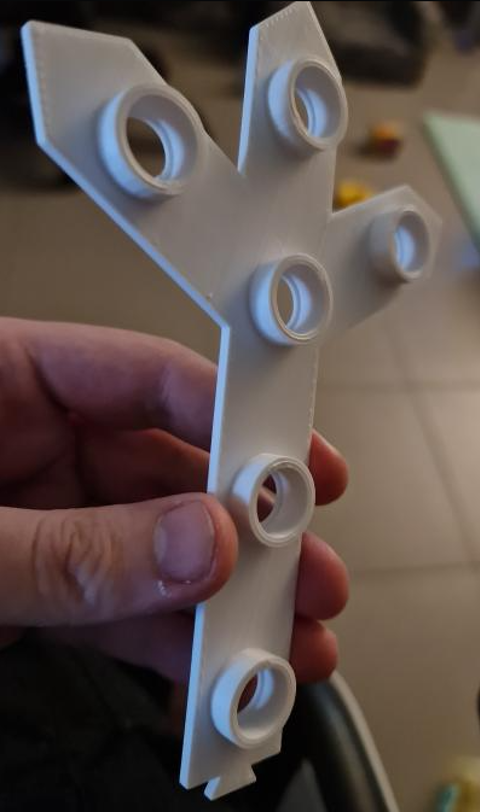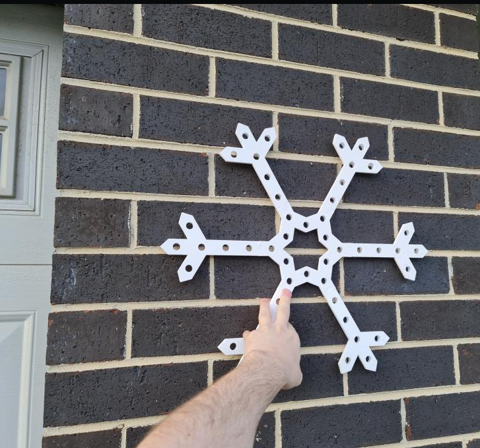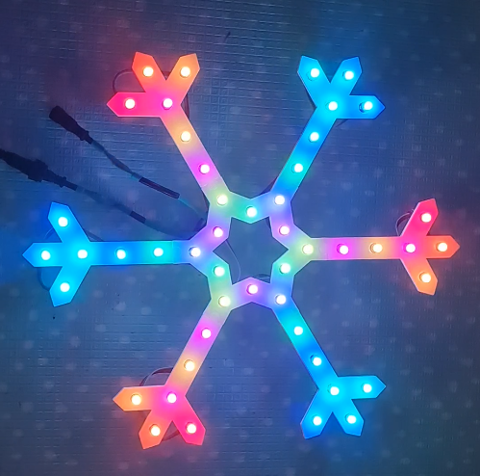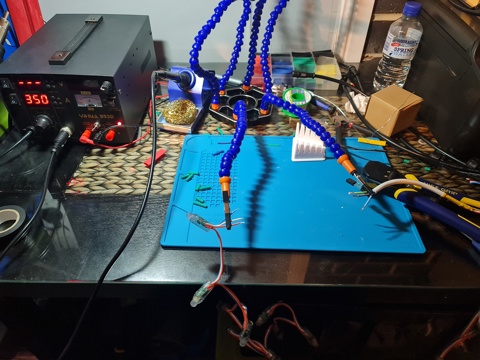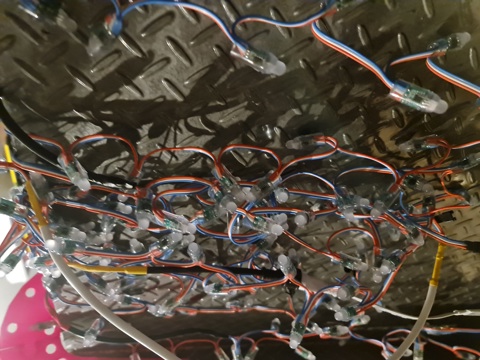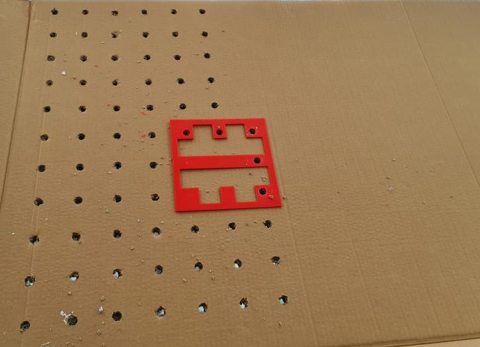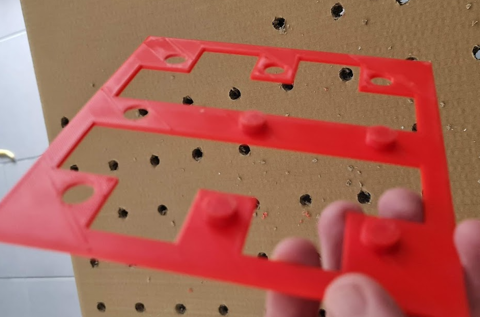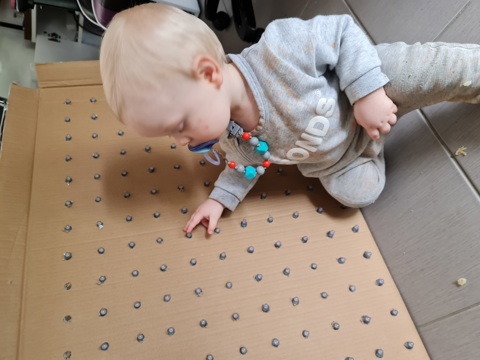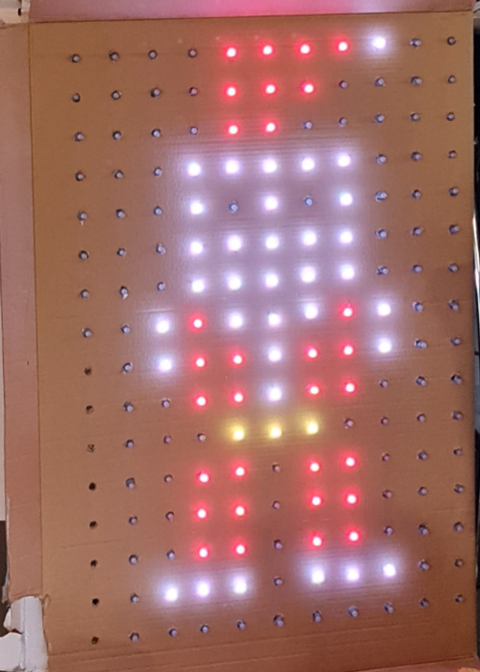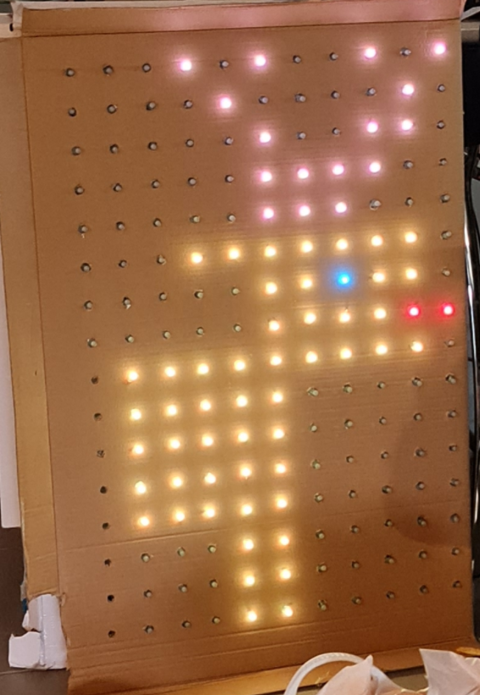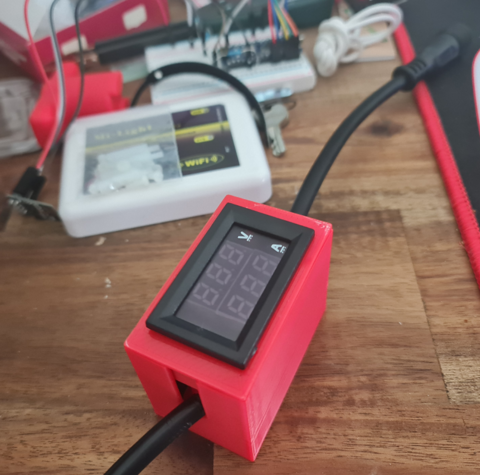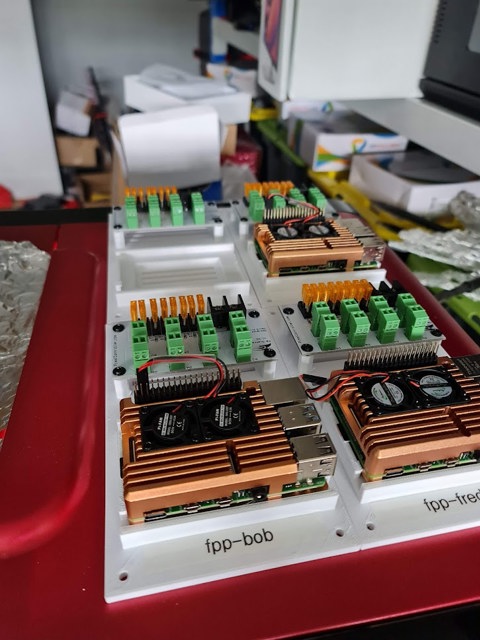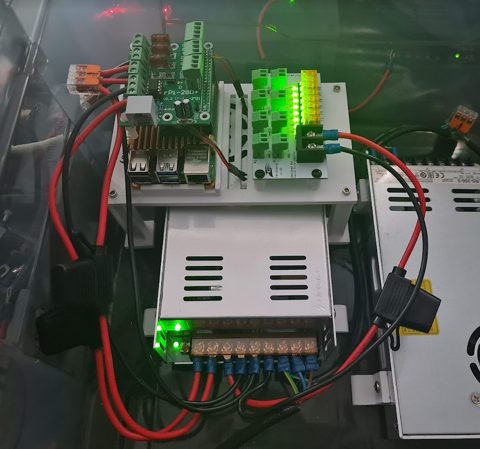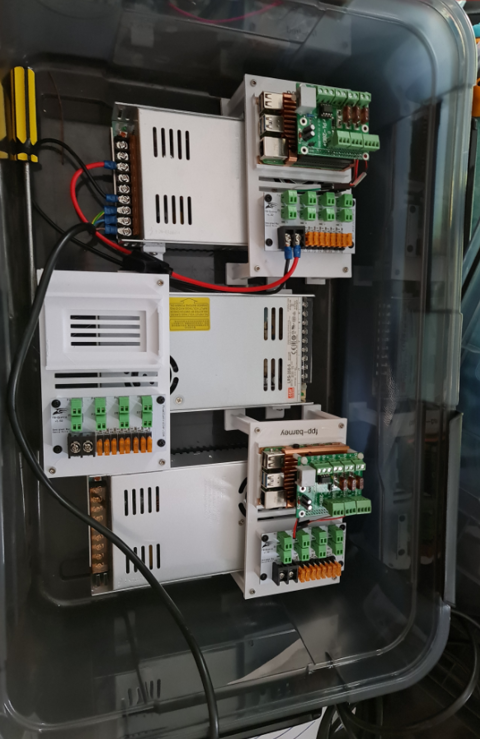Links
Tags
Building a Synchronised Christmas Lights to Music Display - Part 4
With only seven weeks to go, the pressure is on to get all the gear on the house in the next two to three weeks. The same "90% of the work takes 90% of the time, 10% takes the other 90% of time" statement often given to IT projects rings true here too. There has definitely been a lot of work done, but mostly in the non-visible areas of the setup.
The Singing Faces
One would expect that the star of the show will be the singing faces. After all, seeing the singing faces is what got me into really wanting to do this in the first place. Suffice to say, I finally got enough cabling in to start testing what multiple props together looks like and the result is great.
This was certainly something special to see - the props that I'd been working hard on are finally doing exactly what I asked them to do. It's the same sort of satisfaction one gets out of writing code that "just works" - but this felt different. Perhaps the last time I felt this level of accomplishment might stem all the way back to 2016 during the Tour de France live racing project I was part of. Unfortunately it was also short lived when a second sequence I launched caused some significant flickering and colour changes that I thought I knew the answer to.
Now the problem when you watch several hundred YouTube videos on the trials and tribulations of lighting displays, you might be forgiven to thinking you know the answer to any number of problems you may experience. The obvious answer to me was power injection - but I had a T Junction between each of these props, so that shouldn't have been a problem (you can see in the image above the little red volt ammeter box I made in the previous post). While there was an expected voltage drop, the power injection should have absolutely compensated for it. In fact, I even set the brightness from 30% up to 60% expecting a number of pixels to go red (first one to light in a chain) but nope - the flickering didn't seem any worse or better.
The next thing I tried was to swap over the power injection wires in case I had butchered something in the wiring process. I have a collection of 2 pin and 3 pin cables - so swapping these out might also help. Nada. Changed ports on the Power Distribution modules in the power boxes - still the flashing exists. It was getting late so I gave up for the night only to revisit thinking that maybe it requires a signal boost. I'm still not sure why I thought that'd be necessary - after all, each "pixel" should 'regenerate' the ws2811 signal relative to ground so perhaps that was it - but again, power injection should fix that. Several other fixes later, and I tried to work out why one sequence worked and all of the others didn't. Honestly I should have spent more time on this aspect than the others. After watching a few more videos about how the WS2811 signal works (keeping in mind I don't have an oscilloscope), it would appear that if I simply changed the number of output pixels, the flashing would go away (albeit the left hand tree wouldn't light up at all).
Years of problem solving suggests go back to basics and find the odd thing out. The main difference here is that one sequence worked and the other didn't. When I disconnected the left tree, the middle Santa still flickered on that particular sequence so maybe there's something to do with the controller or that sequence. Now, I've been sequencing at 40fps "just because" and never gave it much thought as to how the data would get to the pixel to light up correctly. The 40fps means there's 25ms to process all the data required to light up some 800 pixel x 3 LEDs per pixel. That leaves around 0.0104ms or about 10 microseconds per frame (or 30 microseconds per pixel). So... if you have 800 pixels, and your controller can't quite push 30 microseconds per pixel, you're going to get some corrupted data. In this case, that corrupted data might very well be within lights towards the end of your 'string'. So armed with this thought, I changed the port to rule out a dodgy PWM pin, and sure enough - at 40fps, all three props lit up perfectly and all in sync. To rule out the controller board, I also tested another Raspberry Pi and sure enough - that worked fine on both ports. So yay - on one hand I resolved the issue and on another - I've got a Raspberry Pi 4 that can only push around 400 pixels at 40fps due to something not quite right on this one PWM pin.
Power Distribution
I touched on power distribution last time, but suffice to say I now have two power distribution boxes set up - one for the roof to control the LEDs on the upper half, and one for the ground to do the LED strips, light up props and matrix.
I won't spend a lot of time posting about it - there are plenty of nicer boxes on YouTube and Facebook for this sort of thing but the basics of this setup include:-
- Raspberry Pi 4 with RPi-28D+ capes to run 800 pixels per port (see that flickering post above).
- An 8 port Power Distribution Board
- Either 12V or 5V Power Supply depending on which side of this box I'm plugging stuff into.
In addition, there's a Cat6 socket that plugs into a Ubiquiti Flex Mini switch that's USB-C and POE Powered (yay! found a use for another draw hog) - so these will work nicely under the roof line. To help with some electrical safety here, each input and output is 'fused' to their correct rating - the idea being if we get a short, we'll reduce the risk of something burning.
That's probably all I'll say about this - I wouldn't want you taking electrical advice from a software developer.
Building the PVC Matrix
Ok - so here's an interesting one born out of some ideas borrowed from this video. This is going to be a 50 x 20 pixel matrix cut into 2.5m sections and 5cm spacing. I mocked up several 3D Printed designs - which frankly have been useful but a total waste of time (even when printed at 100% infill, the ABS just isn't quite strong enough to hold the PVC Pipe in place. I also didn't have a drill press, so having 3D printed drill guides helped create some kind of straightness although far from perfect. After several hours dedicated to drilling holes into PVC, the rest is down to painting.
The video I mentioned earlier makes this look easy - frankly this is perhaps the most annoying of all the props to assemble. After painting, I've managed to scratch the paintwork pretty extensively using my 'rings' that will hold and space the PVC pipes together. It's also been super time consuming. Doing this again, I'd probably opt to look at some of the commercial offerings - whether that's chicken wire with 5cm spacing and 3D print 1,000 mounting circles or something else.
Anyway - pictures on this one to come.
Building a Synchronised Christmas Lights to Music Display - Part 3
In less than a month, I'm expecting to find myself scuttling across the roof putting up a lot of LED strips and somehow mounting the props mentioned in my last post to the house, and on the front lawn. Unfortunately for me and a package of 1,000 lights and additional connectors is still in the mail has now been delayed for several weeks due to COVID-19. Thankfully this package is to build out the LED matrix, so perhaps in a couple of weeks time I'll be detailing how that gets built as a shorter post. In any case, there's still been progress.
Snowflakes out of scrap
I received my order from China a few weeks back with all of the LED strips, cheap 'promotion' 5V pixels and a number of cables needed to wire this show up. These 'promotion' 5V pixels did come with a number of warnings in the forum around voltage drop and drop it certainly did (these were connected using 24AWG wire so the 'workaround' was to power it from both ends. Suffice to say, I can't see them being particularly useful unless you love to solder. Ultimately I did find a use for them, and the result was quite effective - so much so it's up there with one of my favourite props from the whole exercise.
So... out comes Sketchup with a star and fork using something geometrically symmetrical to fit between the pillars of the garage. The end result is pretty neat.
Now the original design here attempted to use angled and thinner connectors, but they proved after printing to be fragile and not easy to 'bash in'. I also played around with thinner bodies and longer 'tubes' to place the bulbs in. There was some merit to the tube but 3mm was just too thin for the rest. So I settled somewhere around 5mm for the width using the Gyroid infill type at 25%, with the bulb holes out to 10mm. Also not quite visible here was I put a 1mm "lip" such that the bulbs can be pushed in place easier than trying to jam them in the 12mm holes. That is, the 1mm piece was 12mm in diameter with the rest of the hole at 13mm.
So... back to the printer at 5mm width, 10mm holes, 1mm lips and what not. The only suggestion may be that I might have made them slightly larger if I were to print them again.
Now this is my favourite part. To get good adherence, I use a product called 3DLac - it's basically a hairspray type product that I spray onto a 200mm x 200mm glass panel. This keeps the ABS well adhered to the panel, with the side effect of a shiny glossy side. I've not used it for other props, but given how the lip was printed and the holes behind the scenes, I've had to use the shiny side as the exposed side. And I must say - this has really made these 'scrap' snowflakes pop!
So having done this, I've printed a second one and added it to the show. I mentioned earlier about the 'Voltage' drop on the promotional pixels - well, luckily enough normal 5V pixels in strings of 50 appear to light up just fine without any injection. At 24AWG though, the wire is just not thick enough to carry that 5V all the way down the string. By the time you get to about the 35th pixel, at even 30 or 40% brightness, those whites start turning other colours and start blinking. To solve this, I've got a crazy connector at the origin. Basically you inject power at both ends of the 50 pixels and the problem goes away. You can see how impractical this may be if the prop was much larger than 50 pixels. Also - the work to do it, to save a few dollars in my opinion is just not worth it. These pixels from China were priced very well - $9 a string. But the same seller also sells proper gauged ones at the normal size for around $16 AUD complete with the right connectors soldered on. For the extra $7, you get the two connectors pre-soldered, don't have to use heat shrink and don't have to worry too much about splicing wires in a crazy way. Depending on how many of these kinds of snowflakes or smaller props you want, you may save a few dollars by making lots in bulk ... but definitely factor it in when you've got the rest of the house to do.
Preparing for the Matrix by soldering more issues
So to get an idea on what pixel spacing I need, I've needed to solder up all of the remaining bulbs to get enough pixels for testing. So I heat up the soldering iron, cut up a whole heap of heat-shrink and start assembling the bulbs.
A few hours later, and I've got lots more bulbs to use.
So I figure a 5cm spacing between the pixels will give me something of a 50 x 20 panel. It's not going to be high res by any means but should be enough for some blocky Santas, Reindeers and Text on the panel. To assist, I've designed and printed two templates. One with 9 holes to draw the starting bits on the cardboard and another with 5 holes and 4 plugs that can sit in the hole so I can drill through to get some semblance of symmetry. With some pretty big purchases recently, I've got plenty of cardboard to sketch out a miniature version of it - so time to get drilling.
With all the holes drilled out, and the pixels all populated, my son gave it a good test.
Now it's time to put some pixel art up and the first thing I notice is the colours were slightly off. Now I'm not a great artist by any means, but that red stick figure up there looks familiar... although I don't think I'd want to meet him in a dark alley.
I had originally planned to only go 16 layers (800 pixels total) but these pictures pointed out that I probably need a couple of extra each side to allow for any borders or two lines of text (8 pixels high each with some spacing).
I'm pretty sure at night these will look alright but there are a few things to note that might seem obvious to those that have worked with lights before:
- Brown is an incredibly difficult colour to reproduce. Browns, yellows and oranges in daylight are near indistinguishable - at least on these pixels.
- Spacing even at 5cm does need some considerable distance to be readable. I'm hoping that those viewing the show will be a good 6m away at least.
- Density is good - but you will quadruple the number of pixels (i.e. 2.5cm spacing would build a 100 x 40 display - some 4,000 pixels! that's getting quite expensive and still not particularly high res).
There are a few alternatives, like P10 panels - they're a 32 x 16 panel at 10mm spacing. That gives you 320mm x 160mm. To make a similar size matrix, I'd need 8 across and 6 down (maybe 7, depends what your margin of error is going to be). Apart from the insane cost of buying 48 of these things, let alone the power supplies required to power all those pixels, you'd get a decent resolution - 256 x 96 - but ... I don't know. I've never found those sorts of matrixes to be any good for things other than clearer text. I think it takes something out of the 'twinkle' effect. And I'm sure people say that about LED Strips and WS2811 Bullet Pixels too.
Then there's the possibility of using a Projector. I could project images, but I think the two techniques would create a bizarre distortion as the viewer where there's bright lights somewhere and a too-high resolution with a different brightness just not quite creating a synergy I like to see in displays. So suffice to say - I'm hoping the matrix works but I wouldn't be totally upset if I ended up replacing it with icicles or maybe a mini-mega tree in the future. A few P10 panels for some text might not go astray - but it might only be a 6 x 2 kind of deal rather than all 48 of them. Plus I think there's something to be said about Tom BetGeorge's show and his use of a matrix on his Garage Door that I might like to replicate at some point in the future...
Accessories to power the show with
There's been a lot of posting about the props and the fun stuff. Behind the scenes stuff is also important. This is where things get a little more interesting but also more familiar. Before I start, if you're reading this planning on running your own show, there are plenty of 'out of the box' kits and what not that you can buy for the show execution perspective. Certainly more out of the box than my setup here.
One of the more common boards people are buying to run their shows with include the Falcon Boards from PixelController.com. Now when I say "out of the box" I don't mean you're going to buy one of these and all the lights and power supplies to go with it in some kind of kit, just that in order to control your lights - these are fairly plug and play when I look at the instructions for these. As you may appreciate, each one of these does cost a significant amount of dollaridoos - and at these prices, I would have been turned me away from building the show in the first place. Don't get me wrong, I can see the value in those sorts of boards and the convenience you can get by using Cat6 everywhere - especially if you don't own gear already. But these, paired with 'differential boards' and receivers, can cost a fair chunk of coin so you're going to want to be absolutely sure of heading into this 'hobby' by preparing to land quite a few hundred dollars on controllers.
Now regular readers will know I have draws full of Raspberry Pi's and Arduino's. You can buy the Raspberry Pi Zero with Headers for around $20 AUD in Australia (albeit there are shortages at the moment), and even less if you're prepared to solder them on yourself - and I'd suggest that if you are planning to start a show of this scale, you're going to become very acquainted with a soldering iron to be able to perform such a thing. If using Pi Zero's, you're going to also want to think about Ethernet via USB. I'm unsure on how things will cope running 2.4Ghz Wifi, so consider that in your plans. In my case, I had several Raspberry Pi 4's from a Kubernetes cluster that will be running the show for me this year. When I purchased mine, they were around $60 AUD each from PBTech in Sydney (some New Zealand company that seemed to be able to ship from Australia). That's not their usual price - they can be $100 AUD or more. They don't have to be Pi 4's, this is not CPU or Memory intensive - as evidenced by the ability to use Pi Zero's so if you've got Pi 2's and Pi 3's lying around, use those. For my particular show, there'll be 4 x Raspberry Pi's in total.
- 1 x Raspberry Pi to control all Props (singing trees and Santa, as well as the lawn props - some 1,150 LEDs).
- 1 x Raspberry Pi to control all LED Strips (roof mounted and front of house mounted - some 1,600 LEDs).
- 1 x Raspberry Pi to control the Matrix and 5V Props (matrix is 1,000 LEDs, the other props may be 100-200).
- 1 x Raspberry Pi to act as the master for all these other Pis.
So if you were to buy all this stuff up front, we're either at $80 AUD because you went the Pi Zero model, or $250 AUD+ for new Pi 4's. Now that Falcon board doesn't seem half bad, even when you start factoring in differential controllers. On the other hand, if like me you have a draw full of them - the net cost is $0. So for me, it was a win to stick with the Pi's.
There are only two GPIO pins that really support the data port for WS2811. They apparently power around 800 LEDs per pin, but that's quite a subjective topic based on how many frames per second you can push. I've tried a few things and won't have an answer yet on frame rates until it's installed and running - but I'm not too worried here. Most people watching will be mesmorised by the lights rather than worrying about framerates.
Hanson Electronics - a local supplier has made a custom board to help deliver the power to 'two strands' of WS2811 as well as other things. It comes totally fused and will power the Raspberry Pi itself with a 12V connector or a 5V connector. This 'all in one' board makes this a heck of a lot more convenient to wire things up safely (albeit I did fuse the inputs for both the Pi power and the LED outputs, just in case those cheap power supplies play any tricks on me). The board is the RPi-28D+ - and comes with fuses already installed. Absolutely beautiful. They're well priced too at $38 AUD each. I need 3 of them, so a little pricey in that regard - but they're going to save a lot of time and heart ache trying to power these things via other methods. So I think they're worth it.
- 3 x RPi-28D+ Hats to run WS2811 strings. Around 1,600 pixels supported per hat, 800 per port. You can push more but apparently things might not push the full frame rate. That's OK - adjustments can be made once it's all set up and going.
In order to distribute power to each of these pixels (Voltage Drop and having enough Amps without burning wires out), I needed to think about fusing them. Amazon had a good deal on these 12 V Rextin Power Supplies - the same company that did the LEDs, so I thought I'd give it a go and buy two of them for the 12V pixel stuff. So with 25 A input from these, I needed to figure out a way to get power to the LEDs.
Now a word of warning, this is all anecdotal. There are plenty of videos on YouTube explaining this better than I can so do your research before taking on power injection. Basically I found that if I have some 200 12V pixels in, give or take, I can power Santa Claus on full bright white start at 12 V at the input side and have a drop to about 8 V at the other end of the wire. If I were to add more pixels without injecting power, eventually the Voltage Drop would be so low that there would be no power left to light up those bulbs or you'd get some really strange colours. So to handle this, you need to make a sort of T Junction between those props (or strings if it's one continuous one). At that T junction, you inject a further 12V into the line such that nearby pixels have access to 12V and not the dropped 8V - this is done from the same power supply. Typically I find only 3-4 Amps might be consumed, using the tester I've made using that (picture below).
So in order to distribute power, I'd need several 12V lines running from the power supply to power things. The trick is, the power supply only has 3 outputs that are unfused - so this brings about another situation you want to solve - and that is what happens if you get a short. You certainly don't want some 30A passing down your tiny little wires, unless you plan on having a very toasty fire going on.
Thankfully, this problem has been solved several times over. In my case, from that PixelControllers group I was able to locally source from Light it Up LEDs the F8-Distro controller for around $20. I procured 4 of these, complete with fuses ready to add to each Power Supply. With a bunch of T Connectors in the China order and some more coming from Light it Up LEDs, I should have plenty of options in order to inject power where necessary.
- 4 x F8 Distro Controllers to distribute power
- 2 x 12 V Power Supplies 300W
- 2 x 5 V Power Supplies 300W
It's possible to use Server Grade power supplies, and now I'm kind of kicking myself for chucking out old IBM servers that had 700W power supplies in them - they would have made for great cheaper power supplies if I could extract the 12V from them - but anyway a thought for anyone that may have old ATX and Server Power Supplies around. There are a lot of breakout boards, especially targeted at things like Bitcoin rigs, that can turn those power supplies into readily available 12V DC sources.
So with the parts above out of the way, it's not cheap but spending just over $250 AUD on controllers and power supplies meant I'd saved an absolute bucket load on controller stuff for this show. I'd have liked it to come in just a bit cheaper but this is certainly the area you want to be sure on as there is a genuine fire risk here if you get it wrong.
Now off to the 3D printer again to design some mounts for the Power Supply and Raspberry Pis. This mount took a few goes to get right again. This design uses a clip system to keep those Raspberry Pi's mounted in a way that allows those 'Armour' fans to sit in. They're very snug in there, they won't be escaping out. The F8 Distro boards sitting next to them are screwed in using some Brass Threaded Heat Set inserts. Basically you use the tip of your soldering iron to melt those into place so that you can screw things into them. Note that one of these is missing a Raspberry Pi. This one will live with a 5V power supply that's only supplying additional power to some LED strips.
With these boards and distribution blocks sorted out, it's time to mount the RPi-28D+ hats and start delivering power to these things.
Having raided my draw for 12 AWG wire, fuses and Wago nuts for distributing the 12V line between the two strings of LEDs, I'm pretty happy with the outcome here. All that's left is to wire up the other two power supplies in the same waterproof tub before putting the box through a few tests.
There are still a few more steps here. One is to put a Smoke Alarm or heat detector in here. The last thing we need is a fire to go on within these boxes. There are fans yet to be installed (need to get a gasket system going to keep this box sealed), and I need to test that the box is genuinely waterproof before drilling lots of holes in it. None-the-less, it's a tight but 'good enough' box I think to get started with. There's a fourth box still to build - this will form part of the roof kit. That one will absolutely need a heat sensor that can cut power to itself - and a warning via some other passive system (i.e. smoke alarm) that if things start getting too hot up there it can be manually disconnected. I'm a little paranoid about it and I don't think it's too much to have those protections in place.
Anyway - hope you've enjoyed this post - this last section has been a bit dry. Once it's all assembled, I might even look at doing a video for how it's all assembled. Hopefully the next post can reveal the LED matrix and some of the supporting brackets to go with it. Come on AusPost, deliver already!
